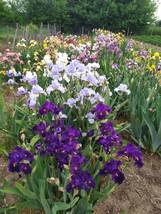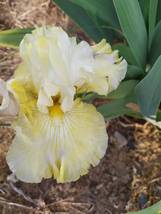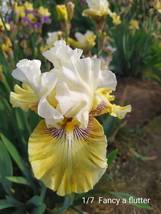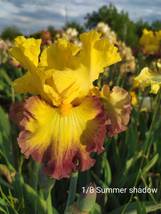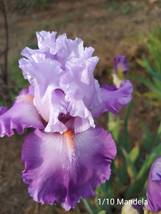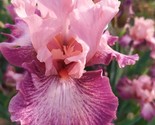Rendered at 00:00:03 10/29/25
Sign up and get $15.00 bCredits free to use at checkout and another $5.00 bCredits when you make your first purchase. More info
Envío gratis
Tall Bearded Iris germanica rhizome
€7,72 EUR
(It may be possible to pay only $8.00 instead of $8.99 when you
use your bCredits at checkout)
Sign up and get $15.00 bCredits free to use at checkout and another $5.00 bCredits when you make your first purchase. More info
Los buques de
Bulgaria

Share & earn! Sign in, share this or any listing, and you’ll get commission when it sells.
Learn more
Las opciones de envío
No hay precio de envío se especifica en ES
Los buques de
Bulgaria

Política de oferta
OBO - El vendedor acepta ofertas en este artículo.
Detalles
La política de devoluciones
Protección de compra
Opciones de pago
PayPal accepted
PayPal Credit accepted
Venmo accepted
PayPal, MasterCard, Visa, Discover, and American Express accepted
Maestro accepted
Amazon Pay accepted
Nuvei accepted
Las opciones de envío
No hay precio de envío se especifica en ES
Los buques de
Bulgaria

Política de oferta
OBO - El vendedor acepta ofertas en este artículo.
Detalles
La política de devoluciones
Protección de compra
Opciones de pago
PayPal accepted
PayPal Credit accepted
Venmo accepted
PayPal, MasterCard, Visa, Discover, and American Express accepted
Maestro accepted
Amazon Pay accepted
Nuvei accepted
Rasgos del artículo
| Categoría: | |
|---|---|
| cantidad disponible: |
57 En stock |
| Condition: |
New |
| Brand: |
Unbranded |
| Country/Region of Manufacture: |
Bulgaria |
Detalles del anuncio
| Envío de descuento: |
No ofrece el envío combinado |
|---|---|
| Publicado en venta: |
Más de una semana |
| Artículo número: |
1667296328 |
Descripción del Artículo
Tall Bearded Iris germanica RHIZOME
Bearded Iris Care
The most popular of the irises, bearded irises are easy to grow provided you plant them in a sunny site with well-drained soil. A major departure for growing irises compared to other perennials is that they do not like mulch. Mulches (as well as deep planting) encourage the rhizomes to develop rot, so let your soil remain bare. Space plants at least 12 inches apart to prevent the need for frequent dividing.
Though iris do not suffer from many problems, routine lifting and dividing is necessary to combat iris borer worms and keep plants healthy and productive.
Light
Irises need full sun to thrive. Irises in full shade produce fewer blooms and may suffer from an increase in diseases.
Soil
Heavy clay soils do not work well for growing iris, but sandy or gravelly soils are excellent. If your native soil is heavy, you can plant irises in raised beds to help drainage. You may also amend your soil with gypsum or organic matter like compost to lighten the soil.
Water
Although irises like moisture, they also need good drainage to prevent rot problems. Water them when the top 2 inches of the soil feels dry. These plants have a good tolerance for drought.
Temperature and Humidity
Irises are notorious for their hardy disposition. They don't mind temperature extremes, as long as the soil allows excess rain or snowmelt to drain away. Irises that are damaged by heavy winds or hail can be susceptible to iris borer larvae.
Fertilizer
In the spring, apply a low-nitrogen 6-10-10 fertilizer around your irises. Too much nitrogen will encourage foliage at the expense of blooms. Bone meal is also a good fertilizer.
Pruning
Faded, withered flowers should be pinched off immediately. This may promote additional blooms or even a repeat bloom period later in the season.
Every four or five years, clumps of iris should be dug up, divided, and replanted in order to cull out diseased roots and iris borer damage. This will keep iris plants vigorous and also allow you to propagate new plants.
Propagating Bearded Iris
Dividing irises not only yields more plants for your garden, but it also keeps your existing irises healthy and vigorous. Here's how to do it:
In late summer, dig up the rhizomes with a shovel, and shake off all loose soil. Any flower stalks that are still in place can be removed at this time.
Carefully pull or cut the rhizome cluster apart into sections. Make sure each section has a fan of foliage; you can trim the foliage off at an angle, leaving 3 to 6 inches of leaves intact.
Examine the root sections closely, and use pruners to cut away any soft, rotten parts. Make sure to cut the roots back past any borer tunnels—you may even encounter living worms, which should be destroyed.
Replant each root section, just barely covering the rhizome. Space roots at least 12 inches apart; they will quickly fill in the spaces. Water thoroughly upon planting, then weekly until frost sets in. New foliage growth will probably begin in late summer and fall, and the plant will grow vigorously when it returns in the spring.
Divide irises every three to five years—or more often if iris borers have infiltrated the plants.
Get an item reminder
We'll email you a link to your item now and follow up with a single reminder (if you'd like one). That's it! No spam, no hassle.
Already have an account?
Log in and add this item to your wish list.




